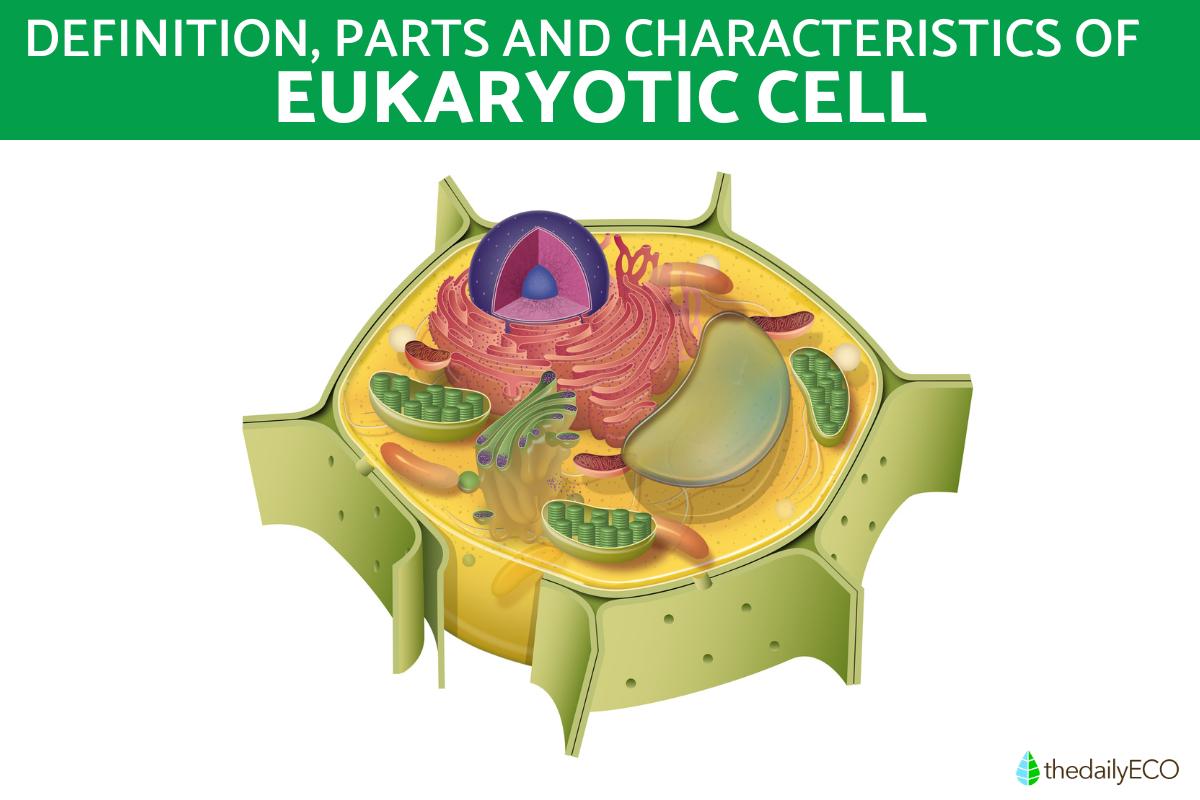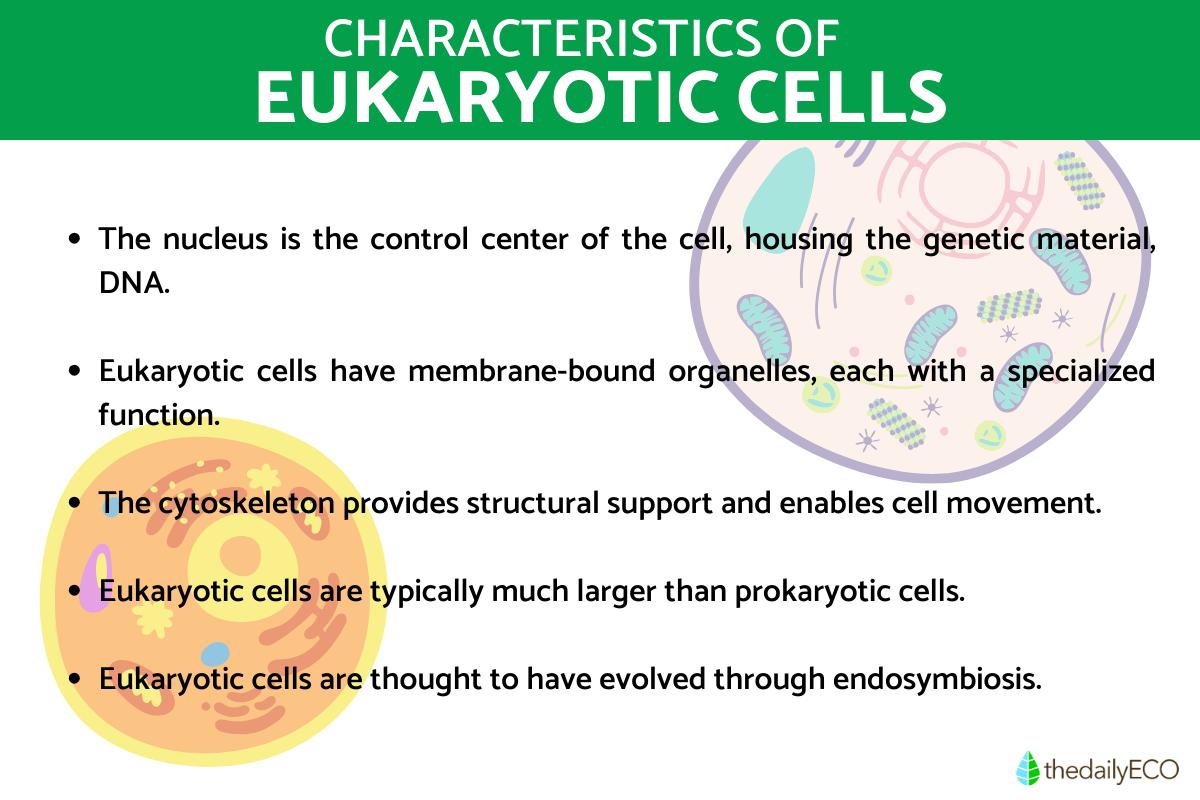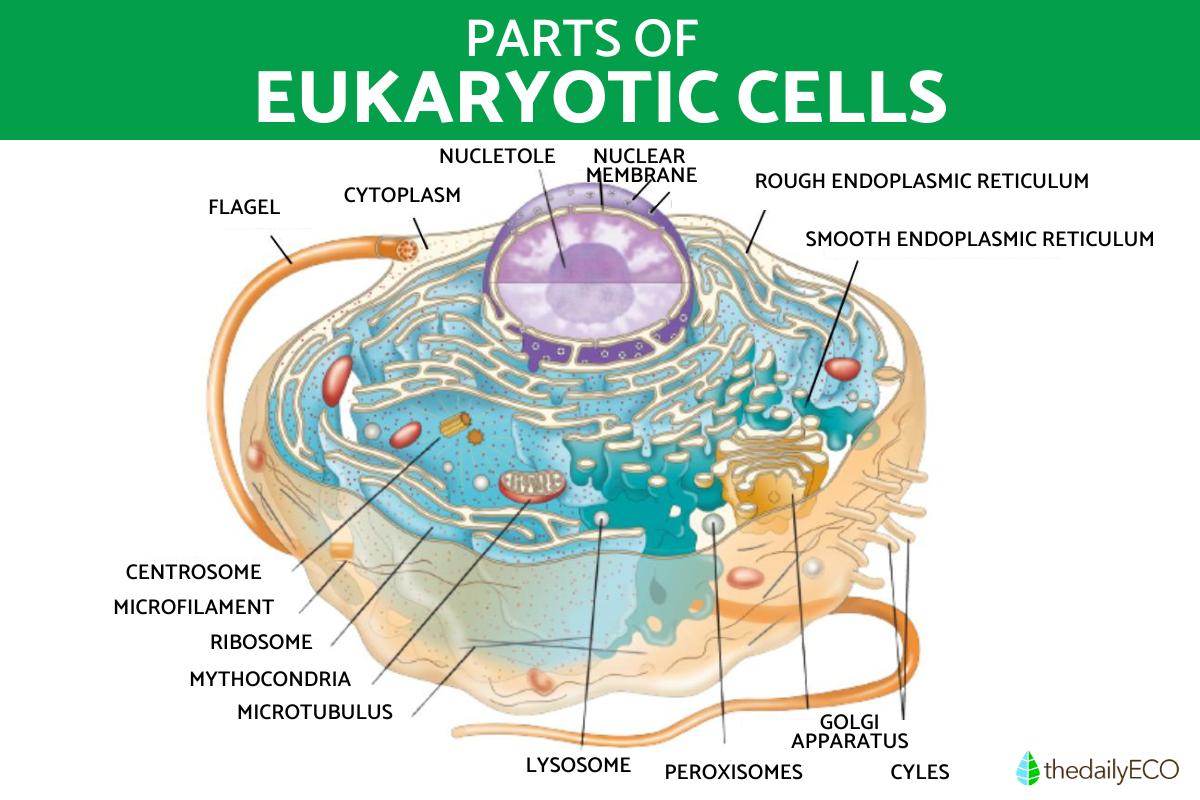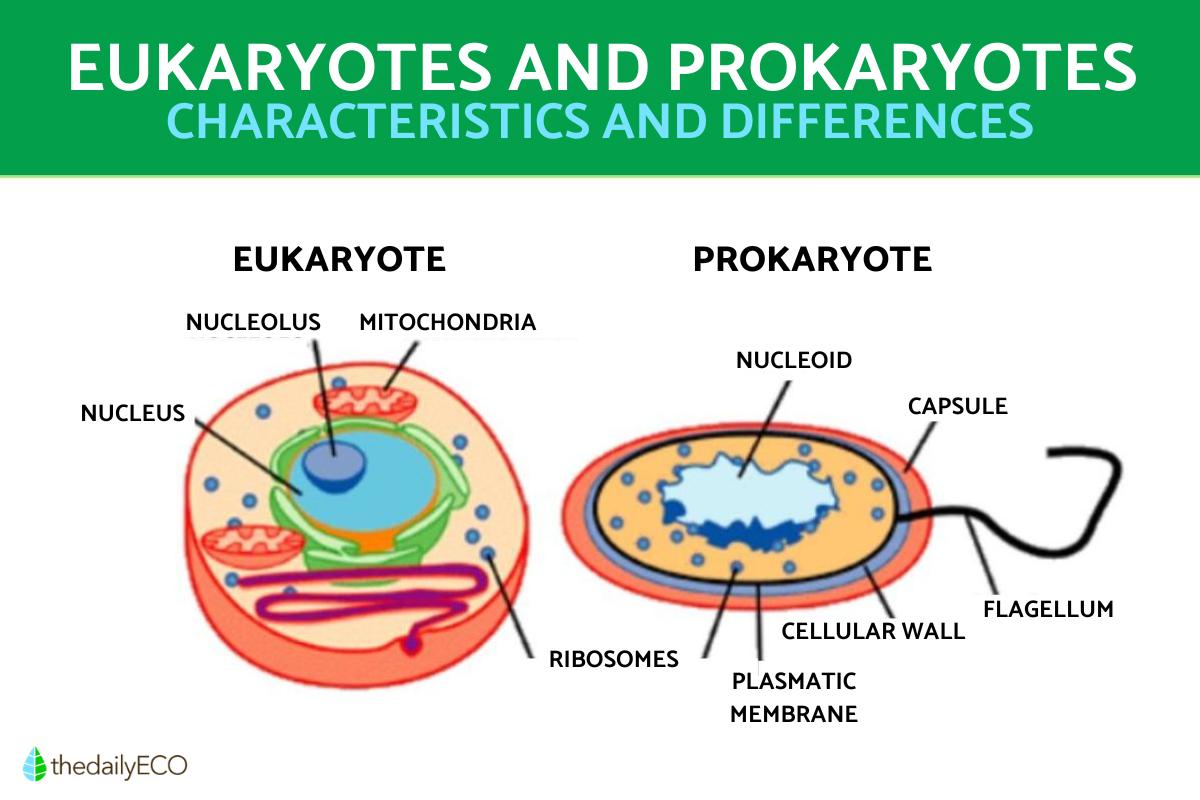Eukaryotic Cell - Vital Components and Processes


Eukaryotic cells are the fundamental building blocks of life, forming the structural and functional basis of plants, animals, fungi, and protists. These cells are distinguished by their complex internal organization, featuring a true nucleus, membrane-bound organelles, and a cytoskeleton. In contrast to simpler prokaryotic cells, eukaryotic cells possess a higher level of organization and specialization, enabling them to carry out a wider range of functions and contribute to the remarkable diversity of life on Earth.
In the upcoming article by thedailyECO, we will provide an explanation of what eukaryotic cells are, delve into their various components, explore their reproduction mechanisms, and discuss their significance and functions.
- What are eukaryotic cells and characteristics?
- What are the parts of an eukaryotic cell?
- What is the role of the eukaryote cells?
- How do eukaryotic cells reproduce?
- Types of eukaryotic cells
- What is the size of a eukaryotic cell?
- Importance of eukaryotic cells
- What is the difference between a prokaryotic and eukaryotic cell?
What are eukaryotic cells and characteristics?
Eukaryotic cells are the cells that make up the bodies of plants, animals, fungi, and protists.
They are more complex than prokaryotic cells, which are the cells that make up the bodies of bacteria and archaea. Eukaryotic cells have a nucleus, which is a membrane-bound organelle that contains the cell's DNA. They also have other membrane-bound organelles, such as mitochondria, endoplasmic reticulum, Golgi apparatus, lysosomes, and peroxisomes.
Here are some of the key characteristics of eukaryotic cells:
- They have a nucleus, which contains the cell's DNA.
- They have membrane-bound organelles, which are specialized structures that carry out different functions within the cell.
- They have a cytoskeleton, which is a network of protein fibers that helps to support the cell and give it its shape.
- They have a cell wall, which is a rigid layer that surrounds the cell membrane and provides protection and support.
- They have cilia and flagella, which are hair-like structures that help the cell to move.
- They reproduce sexually, which involves the fusion of two cells to produce a new cell.
Eukaryotic cells are found in a wide variety of organisms, from single-celled protists to complex multicellular plants and animals. They are the most diverse type of cell, and they play a vital role in the life of all living things.

What are the parts of an eukaryotic cell?
The eukaryotic cell functions as a sophisticated mechanism, with all components intricately coordinated. It houses diverse organelles, each with specialized functions, acting as factories, storage units, processors, or excretory systems.
Key organelles in Eukaryotic cells:
- Nucleus: holds genetic info and manages RNA production.
- Cell wall: not in all cells, but provides support, defines the cell, and helps with substance exchange.
- Ribosomes: make proteins, consisting of 60% proteins and 40% RNA.
- Cytoplasm: the cell's main area with a supporting structure called microtubules. The liquid part, called cytosol, has ions, glucose, and other molecules.
- Mitochondria: has folds (cristae) that increase the area for important processes during respiration.
- Rough Endoplasmic Reticulum (RER): covered in ribosomes, located near the cell nucleus.
- Smooth Endoplasmic Reticulum (SER): similar to RER but without ribosomes, doing different jobs.
- Golgi apparatus: made of flat sacs, handling the processing and packing of cell products.
- Lysosomes: small bags with various molecules.
- Peroxisomes: tiny bags with enzymes that create water and oxygen.
- Centrioles: structures formed when it's time for cells to divide.
- Extra parts: some cells have cilia or flagella for moving or catching things.
Delve deeper into the world of organelles with our comprehensive guide to their diverse functions and essential roles in cellular life.

What is the role of the eukaryote cells?
The eukaryotic cell performs several crucial functions essential for the survival and functioning of organisms. Here's a concise breakdown:
- Cellular respiration: takes place in the mitochondria, producing energy (ATP) for various cellular activities.
- Protein Synthesis: facilitated by ribosomes, proteins are synthesized, supporting cell structure and function.
- Lipid synthesis and toxin elimination: the Smooth Endoplasmic Reticulum is involved in lipid synthesis, and it helps eliminate toxins to maintain cell health.
- Transport of manufactured products: the Golgi Apparatus processes and packages cellular products for efficient transport within and outside the cell.
- Molecule processing: lysosomes and peroxisomes are responsible for breaking down and processing various molecules, ensuring cellular balance.
- Gene expression: occurs in the cell nucleus, involving transcription and translation, regulating the synthesis of proteins and other cellular components.
- Reproduction: eukaryotic cells have the ability to reproduce, a fundamental process for the growth and maintenance of living organisms.
Embark on a journey within the microscopic world to uncover the secrets of the nucleus, the command center that governs the symphony of life within every cell.
How do eukaryotic cells reproduce?
The reproduction of eukaryotic cells involves two fundamental processes: asexual reproduction and sexual reproduction.
Asexual Reproduction
Asexual reproduction involves the division of a single parent cell into two or more genetically identical daughter cells. This process does not require the fusion of gametes and produces offspring with the same genetic makeup as the parent cell.
There are two main types of asexual reproduction in eukaryotic cells:
- Binary fission: is the simplest mode of asexual reproduction, where the parent cell divides into two identical daughter cells. This process is common in single-celled eukaryotic organisms, such as amoebas and paramecia.
- Mitotic cell division: is a more complex process that occurs in multicellular eukaryotic organisms. It involves a series of steps that ensure the equal distribution of chromosomes to daughter cells, resulting in genetically identical offspring.
Asexual reproduction is an efficient and rapid mode of reproduction, allowing for the quick expansion of populations under favorable conditions. However, it lacks the genetic diversity that can arise from sexual reproduction.
Sexual Reproduction
Sexual reproduction involves the fusion of two specialized sex cells, called gametes, to produce a new cell called a zygote. The zygote undergoes further development to form a new individual. Sexual reproduction introduces genetic variation into the offspring, increasing the chances of survival and adaptation in changing environments.
There are also two main types of sexual reproduction in eukaryotic cells:
- Isogamy: occurs when two gametes of the same size and structure fuse. This type of sexual reproduction is less common and is typically observed in unicellular organisms.
- Anisogamy: occurs when two gametes of different sizes and structures fuse. This type of sexual reproduction is more prevalent and is often seen in multicellular organisms, where the gametes are typically categorized as male (sperm) and female (egg).
Sexual reproduction is a more complex and time-consuming process compared to asexual reproduction. However, it introduces genetic diversity, which can enhance the adaptability of a population and increase its chances of survival in changing environments.
Types of eukaryotic cells
Eukaryotic cells are diverse and can be classified into different types based on their structure, function, and specialization. Here are some common types of eukaryotic cells:
- Animal cells: found in the tissues of animals, these cells lack a cell wall and typically have a round or irregular shape. They contain various organelles, including a nucleus, mitochondria, and endoplasmic reticulum.
- Plant cells: present in plant tissues, these cells have a rigid cell wall made of cellulose, providing structural support. Plant cells also contain chloroplasts for photosynthesis, in addition to the usual eukaryotic organelles.
- Fungal cells: comprising the cells of fungi, these cells have a cell wall made of chitin. Fungal cells can form hyphae, which are thread-like structures that make up the body of a fungus.
- Protozoan cells: found in single-celled eukaryotic organisms called protozoa, these cells often have structures like cilia or flagella for movement. They can be free-living or parasitic.
- Algal cells: algae are diverse photosynthetic organisms, and their cells can vary widely. Some have features similar to plant cells, such as chloroplasts and a cell wall, while others may be more animal-like.
- Eukaryotic microbial cells: include a variety of single-celled microorganisms like amoebas and paramecia. These cells exhibit diverse shapes and structures, often adapted to their specific environments.
- Protoctist cells: protoctists are a diverse group of eukaryotic microorganisms that don't fit into other kingdoms. They include various forms, such as amoebas, algae, and slime molds.
- Human cells: different types of cells make up the human body, including muscle cells, nerve cells, blood cells, and more. Each type is specialized for a specific function within the body.
These are just a few examples, and the diversity of eukaryotic cells is vast. Within each of these categories, there are numerous subtypes and variations based on the specific roles and functions of the cells in different organisms. Additionally, ongoing research may uncover new cell types or refine our understanding of existing ones.
Discover more about the remarkable diversity of cell types, each meticulously designed to perform specific functions, ensuring the harmonious balance and survival of living organisms.
What is the size of a eukaryotic cell?
Eukaryotic cells vary widely in size, and their dimensions depend on the specific type of cell and organism. Generally, eukaryotic cells are larger than prokaryotic cells, which lack a true nucleus and membrane-bound organelles.
The size of eukaryotic cells can range from about 10 to 30 micrometers in diameter. However, some cells can be significantly larger.
In fact, some specialized cells, like bird eggs or certain plant cells, can be visible to the naked eye due to their larger size. The diversity in cell sizes reflects the varied functions and structures of different cell types in the eukaryotic world.
Importance of eukaryotic cells
Eukaryotic cells are the foundation of all complex life on Earth, playing a crucial role in the existence of plants, animals, fungi, and protists. Their unique characteristics and advanced cellular machinery enable them to carry out a wide range of functions essential for life. These functions include:
- Providing the structural basis of life.
- Carrying out diverse metabolic processes.
- Housing and transmitting genetic information.
- Using specialized organelles to perform specific tasks.
- Communicating and signaling with other cells
Eukaryotic cells represent a major advancement in the evolution of life and have contributed to the diversification of life forms and the development of complex ecosystems. Their presence is essential for the existence of all complex organisms on Earth.

What is the difference between a prokaryotic and eukaryotic cell?
Prokaryotic and eukaryotic cells are the two main types of cells found in living organisms. They differ in several fundamental ways, including their structure, organization, and DNA arrangement. Let us take a closer look at their differences:
Structure:
- Prokaryotic cells: are typically smaller and simpler in structure compared to eukaryotic cells. They lack a true nucleus and membrane-bound organelles. Instead, their DNA is found in a region called the nucleoid, and their organelles are free-floating within the cytoplasm.
- Eukaryotic cells: are larger and more complex than prokaryotic cells. They have a membrane-bound nucleus that houses their DNA and membrane-bound organelles that perform specific functions.
Organization
- Prokaryotic cells: are typically unicellular, meaning they exist as single-celled organisms.
- Eukaryotic cells: can be either unicellular or multicellular. Multicellular eukaryotes consist of many different types of cells that work together to form complex tissues, organs, and organisms.
DNA arrangement
- Prokaryotic cells: Prokaryotic cells have a single circular chromosome that is not enclosed in a membrane.
- Eukaryotic cells: Eukaryotic cells have multiple linear chromosomes that are enclosed within a membrane in the nucleus.
It is important to note that, prokaryotic cells, despite their simpler organization, are incredibly diverse and adaptable, and they have thrived for billions of years. Eukaryotic cells, with their more complex machinery, have given rise to the vast diversity of plants, animals, fungi, and protists that we observe today.
For additional details, consider reading another article that delves into the evolution of cells. This piece specifically explores the distinctive features of both eukaryotic and prokaryotic cells.
If you want to read similar articles to Eukaryotic Cell - Vital Components and Processes, we recommend you visit our Biology category.
- Angulo, A., Galindo, A., Avendaño, R., Pérez, C. (2009). Cell Biology. Coahuila: Autonomous University of Sinaloa.








